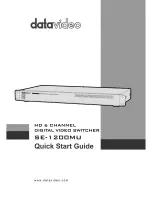
164
|
IPv4 Routing
www.dell.com | support.dell.com
Usage
Information
Using the following example of a static route:
ip route 33.33.33.0 /24 tengigabitethernet 0/0 172.31.5.43
•
The software installs a next hop that is not on the directly connected subnet but which recursively
resolves to a next hop on the interface’s configured subnet. In the example, if gig 0/0 has ip
address on subnet 2.2.2.0 and if 172.31.5.43 recursively resolves to 2.2.2.0, FTOS installs the
static route.
•
When the interface goes down, FTOS withdraws the route.
•
When the interface comes up, FTOS re-installs the route.
•
When recursive resolution is “broken,” FTOS withdraws the route.
•
When recursive resolution is satisfied, FTOS re-installs the route.
Related
Commands
management route
Configure a static route that points to the Management interface or a forwarding router.
Syntax
management route
{
ipv4-address
}
/mask
{
forwarding-router-address
|
managementethernet
}
Parameters
Defaults
Not configured.
Command Modes
CONFIGURATION
Command
History
Usage
Information
When a static route (or a protocol route) overlaps with Management static route, the static route (or a
protocol route) is preferred over the Management Static route. Also, Management static routes and the
Management Connected prefix are not reflected in the hardware routing tables. Separate routing tables
are maintained for IPv4 management routes. This command manages both tables.
show hosts
View the host table and DNS configuration.
Syntax
show hosts
Command Modes
EXEC
EXEC Privilege
Command
History
show ip route
Views the switch routing table.
{
ipv4-address
}
/mask
Enter an IPv4 address (A.B.C.D) followed by the prefix-length for
the IP address of the management interface.
forwarding-router-address
Enter an IPv4 address of a forwarding router.
managementethernet
Enter the keyword
managementethernet
for the Management
interface.
Version 8.3.17.0
Supported on M I/O Aggregator
Version 8.3.17.0
Supported on M I/O Aggregator
Summary of Contents for PowerEdge M IO Aggregator
Page 14: ...12 Before You Start w w w d e l l c o m s u p p o r t d e l l c o m ...
Page 40: ...38 File Management w w w d e l l c o m s u p p o r t d e l l c o m ...
Page 80: ...78 Control and Monitoring w w w d e l l c o m s u p p o r t d e l l c o m ...
Page 90: ...88 u Boot w w w d e l l c o m s u p p o r t d e l l c o m ...
Page 108: ...106 Data Center Bridging w w w d e l l c o m s u p p o r t d e l l c o m ...
Page 114: ...112 Dynamic Host Configuration Protocol DHCP w w w d e l l c o m s u p p o r t d e l l c o m ...
Page 128: ...126 Internet Group Management Protocol IGMP w w w d e l l c o m s u p p o r t d e l l c o m ...
Page 162: ...160 Interfaces w w w d e l l c o m s u p p o r t d e l l c o m ...
Page 178: ...176 IPv4 Routing w w w d e l l c o m s u p p o r t d e l l c o m ...
Page 182: ...180 iSCSI Optimization w w w d e l l c o m s u p p o r t d e l l c o m ...
Page 186: ...184 Link Aggregation Control Protocol LACP w w w d e l l c o m s u p p o r t d e l l c o m ...
Page 190: ...188 Layer 2 w w w d e l l c o m s u p p o r t d e l l c o m ...
Page 210: ...208 Security w w w d e l l c o m s u p p o r t d e l l c o m ...
Page 246: ...244 Uplink Failure Detection UFD w w w d e l l c o m s u p p o r t d e l l c o m ...
Page 262: ...260 Debugging and Diagnostics w w w d e l l c o m s u p p o r t d e l l c o m ...
















































